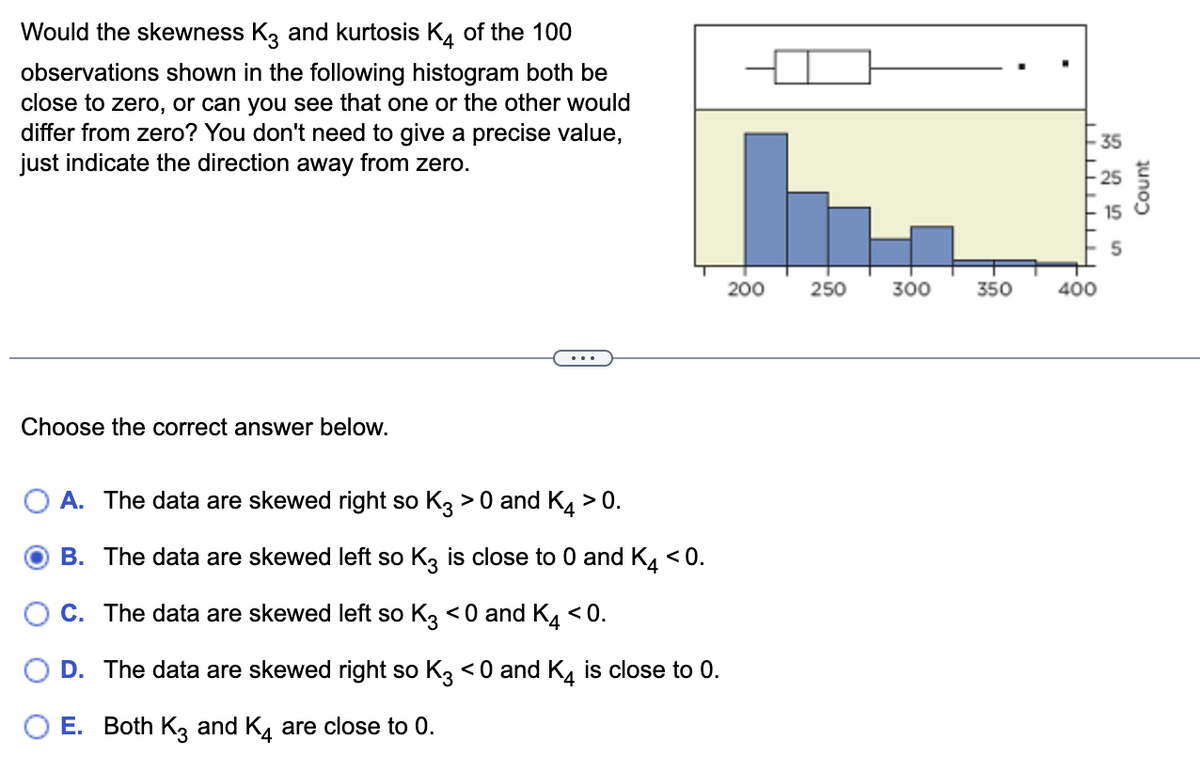Would the skewness K3 and kurtosis K4 of the 100 observations shown in the following histogram both be close to zero, or can you see that one or the other would differ from zero? You don't need to give a precise value, just indicate the direction away from zero. Choose the correct answer below. O A. The data are skewed right so K3 >0 and K4 > 0. B. The data are skewed left so K3 is close to 0 and K4 <0. C. The data are skewed left so K3 <0 and K4 <0. D. The data are skewed right so K3 <0 and K4 is close to 0. O E. Both K3 and K4 are close to 0. 200 250 300 350 400 Count
Would the skewness K3 and kurtosis K4 of the 100 observations shown in the following histogram both be close to zero, or can you see that one or the other would differ from zero? You don't need to give a precise value, just indicate the direction away from zero. Choose the correct answer below. O A. The data are skewed right so K3 >0 and K4 > 0. B. The data are skewed left so K3 is close to 0 and K4 <0. C. The data are skewed left so K3 <0 and K4 <0. D. The data are skewed right so K3 <0 and K4 is close to 0. O E. Both K3 and K4 are close to 0. 200 250 300 350 400 Count
Algebra & Trigonometry with Analytic Geometry
13th Edition
ISBN:9781133382119
Author:Swokowski
Publisher:Swokowski
Chapter2: Equations And Inequalities
Section2.7: More On Inequalities
Problem 44E
Related questions
Question
I need help with this question with explanation.

Transcribed Image Text:Would the skewness K3 and kurtosis K4 of the 100
observations shown in the following histogram both be
close to zero, or can you see that one or the other would
differ from zero? You don't need to give a precise value,
just indicate the direction away from zero.
Choose the correct answer below.
A. The data are skewed right so K3 > 0 and K4 > 0.
B. The data are skewed left so K3 is close to 0 and K4 <0.
C. The data are skewed left so K3 <0 and K4 <0.
D. The data are skewed right so K3 <0 and K4 is close to 0.
E. Both K3 and K4 are close to 0.
200
250
300
350
-35
400
Count
Expert Solution
This question has been solved!
Explore an expertly crafted, step-by-step solution for a thorough understanding of key concepts.
Step by step
Solved in 2 steps

Recommended textbooks for you

Algebra & Trigonometry with Analytic Geometry
Algebra
ISBN:
9781133382119
Author:
Swokowski
Publisher:
Cengage

Linear Algebra: A Modern Introduction
Algebra
ISBN:
9781285463247
Author:
David Poole
Publisher:
Cengage Learning

Algebra & Trigonometry with Analytic Geometry
Algebra
ISBN:
9781133382119
Author:
Swokowski
Publisher:
Cengage

Linear Algebra: A Modern Introduction
Algebra
ISBN:
9781285463247
Author:
David Poole
Publisher:
Cengage Learning